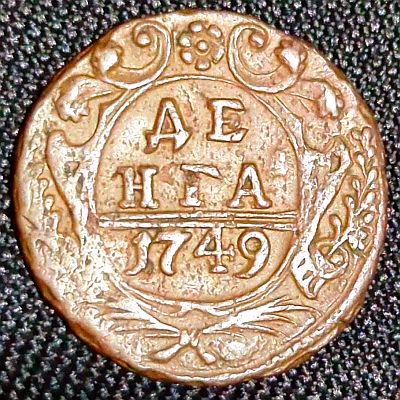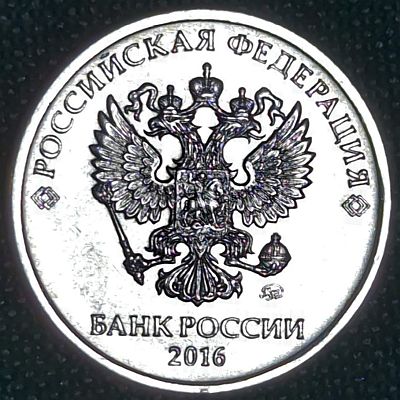The Russian Ruble, used since the 14th century is the second oldest currency still in circulation (the oldest being the UK Pound Sterling. The Ruble is commonly cited as the first currency in Europe to be decimalised in 1704. In fact in 1535, the Denga was worth 1/100 Ruble. But, there is an argument that as Russia continued to use coins outside the decimal system, the US was in fact the first country to go completely decimal. (I can’t find other evidence of that? Happy for any additional info?)

ДЕ and НГА on the reverse of this coin spell DE and NGA. Coins denominated as a “Denga” have been issued for over a thousand years. When this coin was issued in 1749, the Denga was worth 1/2 Kopeck, or 1/200th of a Ruble.
This coin was issued unchanged from 1730 – 1754. This was through the reign of Anna Ioannovna (1730-1740), Ivan VI Antonovich (1740-1741) and partway through the reign of Elizabeth (1741-1762). (A different design was issued from 1757 – 1760.
Anna Ioannovna is widely regarded as the worst Empress Russia had. Ivan was only two months old when he became Emperor, and although his mother, Anna Leopoldovna was named Regent, they were overthrown in a coup by Elizaveta Petrovna. Despite this start, Elizaveta, daughter of Peter the Great, was a very popular Empress. This was partly due to her strong opposition to Prussian policies and her decision not to execute a single person during her reign, an unprecedented one at the time. Several rulers immediately before her had been very pro-German, which was not widely popular.

Back to the Denga, and the obverse features a Double-headed Russian imperial eagle. The Eagle is a very popular national symbol in many countries. The double headed eagle also goes back to ancient time. Carvings of these have been attributed to the Hittites who lived in the Middle East in the 13th century B.C. The bird was quite popular in the Byzantine empire. The Byzantine Emperor used the symbol to emphasize that the empire united both East and West under its wings; the eagle has two heads, but just one body”. In 1472, Ivan III, Moscow’s Grand Prince, married Byzantine princess Sophia Palaiologina. Thus Russia inherited the use of the symbol, in the same was as Serbia, Albania and Montenegro also had.
The heads are topped with one crown floating between them, symbolising unity. The eagle is holding an orb and a scepter, symbolising power and authority. Modern Russian coins continue to bear the double headed eagle:

Finally one last interesting part of the Denga coin is the edge. Where many coins are either smooth or reeded, the Denga has a reticulated edge (with a criss-cross or lattice pattern):

The last Denga was issued in 1828 under Nikolai I.


Leave a Reply